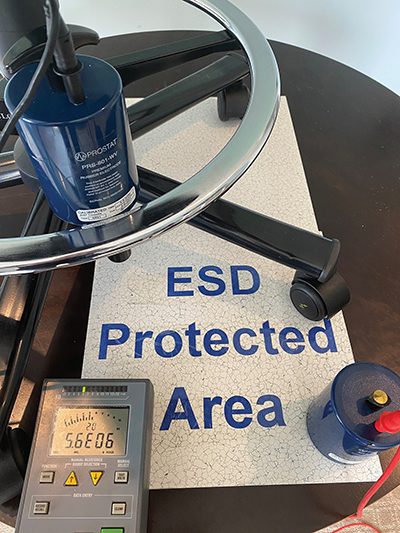Standard ESD Resistance Tests Do Not Fully Evaluate a Floor’s Suitability for Grounding Carts, Chairs, and Mobile Workstations
What’s the purpose of installing an ESD floor? The most common answer to this question is “We need ESD flooring to prevent static charges on mobile personnel when they handle static sensitive parts and systems.” In other words, we need the effectiveness of a wrist strap, but we don’t want to deal with the restrictions of wires and cords.
While this answer highlights a key attribute of a properly functioning ESD floor, it sets the bar very low. It also short sells the many advantages an ESD floor actually offers. Like every other static mitigation component, ESD flooring is only one piece of a larger comprehensive system that keeps all parts, machines, tools, packaging, work surfaces, and personnel at the same potential.
When floors are evaluated, specifiers focus on two main performance parameters: 1) the flooring system’s electrical resistance; and 2) how much charge a person can develop when walking on the floor wearing specific footwear. But what about the parts themselves? How do we protect them? When we move parts from one operation to another, we don’t cradle them in the palm of our hands. We move parts and systems in zip lock bags, on wheeled carts with trays, and possibly with automatically guided vehicles. In agile manufacturing operations, the ESD floor might even be used as the primary ground for workbenches on wheels.
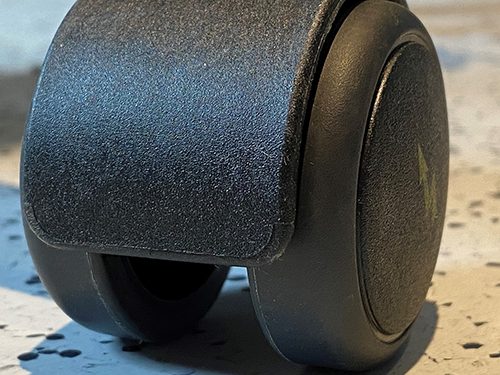
Flooring Basics
ESD floors are designed to prevent static discharge from harming electronic parts and assemblies in an ESD-protected area (EPA.) They are installed for multiple reasons. The ideal floor prevents static on:
- people
- parts and equipment
- shelves, mobile workstations, and ESD chairs
Some ESD floors satisfy all three tasks. Other inhibit static from developing on people but do little or nothing to protect equipment or ground mobile workstations, carts, and ESD chairs.
Why Does This Matter?
To produce quality products, pass ISO certification, and satisfy customers, electronics facilities must meet ANSI/ESD S20.20. In an effort to meet ESD flooring requirements in ANSI 20.20, buyers and specifiers often focus all their attention on the electrical resistance of the flooring/adhesive system. But resistance is only one performance parameter.
Finding floors that meet S20.20 point-to-point (RTT) and point-to-ground (RTG) resistance requirements is an easy task. Adherence to all aspects of ANSI/ESD S20.20 requires the floor to perform multiple functions, and not just meet an electrical resistance parameter. It’s equally important to determine the maximum voltage the floor will generate on a person in combination with specific footwear. Furniture, mobile workstations, and equipment must also be properly grounded through the floor, with resistance between the castors and ESD floor ground within the S20.20 acceptable range (< 1.0 x109).
Below are some tests every end-user should perform when evaluating floors:
- STM 7.1 Acceptable system resistance < 1.0 X 109 (Tool used: Ohm meter and NFPA probes)
- STM 97.1 Acceptable person + footwear + flooring system resistance < 1.0 x 109 (Equipment used: Ohm meter and NFPA probes)
- STM97.2 Maximum voltage measured on a person wearing ESD footwear while walking on an ESD floor: less than 100 volts (Equipment used: Charge plate monitor/field meter)
- STM4.1 Verification (page 18, Section 12.3 TR53-01-18) Maximum resistance between mobile ESD workstation surface and ground while resting on a grounded ESD floor < 1.0 X 109 (Equipment used: Ohm meter and NFPA probes)
A Case History
As part of an ESD tile evaluation by the facilities department at a medical instruments manufacturer, test floors were installed. Various properties were evaluated, including flatness, slip characteristics, flooring system resistance, body voltage generation, ease of rolling heavy equipment, maintenance, and difficulty of installation and repairs.
One of the flooring options met all criteria including the ability to install without adhesive using internal labor. However, prior to ordering the flooring, a manufacturing engineer placed several mobile carts on the test floor and measured resistance to ground from the cart surface through the conductive casters to the floor’s groundable point.
Despite the fact that the floor by itself had measured in the conductive range (< 1.0 x 106) per ANSI/ESD S7.1 tests, the flooring failed the mobile workstation test, with the resistance to ground measurements from the cart surface ranging from 1.0 x 106 to 1.0 x 1012. Per ANSI/ESD S20.20, any measurement > 1.0 x 109 constitutes a failure. Seven measurements out of the initial 40 test points exceeded the ANSI maximum (see Table 1).
| 9 x 10 E6 | 5 x 10 E6 | 6 x 10 E6 | 8 x 10 E6 |
| 1 x 10 E7 | 1 x 10 E6 | 2 x 10 E7 | 7 x 10 E6 |
| 5 x 10 E6 | 1 x 10 E6 | 1 x 10 E7 | 2 x 10 E2 |
| 2 x 10 E8 | 1 x 10 E12 | 1 x 10 E8 | 8 x 10 E6 |
| 5 x 10 E7 | 2 x 10 E7 | 1 x 10 E7 | 7 x 10 E6 |
| 2 x 10 E6 | 2 x 10 E6 | 1 x 10 E1 | 2 x 10 E6 |
| 2 x 10 E10 | 4 x 10 E9 | 1 x 10 E8 | 2 x 10 E10 |
| 5 x 10 E6 | 9 x 10 E7 | 1 x 10 E6 | 9 x 10 E6 |
| 2 x 10 E11 | 9 x 10 E8 | 9 x 10 E9 | 5 x 10 E7 |
| 8 x 10 E7 | 2 x 10 E9 | 9 x 10 E6 | 3 x 10 E9 |
Table 1: 40 resistance measurements from cart surface to groundable point through medium density ESD floor tiles. Cart locations were altered by as little as one inch between measurements. Test area measured over 100 square feet. Multiple areas were tested. Carts were equipped with four conductive casters.
This sampling was followed up with over 1000 measurements. The reject rate was approximately 16%. Was the cart the problem? When placed on a metal plate, the cart resistance to ground measured well below 1.0 x 107. To eliminate contamination as a variable, the flooring and casters were thoroughly cleaned and retested. This had little impact and measurements remained unacceptable. The resistance between the cart and the floor changed by four to six orders of magnitude simply by moving the cart as little as one inch. Given that the flooring resistance and the cart caster resistance exhibited consistency, the only remaining variable was the random placement of casters (caster and floor interface) on the floor tiles.
Analyzing the Data
Figures 2 and 3 are photos of a tray cart commonly found in electronic manufacturing service (EMS) facilities. The cart is resting on a flooring system that utilizes conductive chips. This floor would be categorized as a low density (LD) conductive chip floor. This particular flooring system provides a conductive path from black surface chips through its thickness to a carbon loaded ground plane on the underside. A 24” copper strip was used as a groundable point. When tested with a five-pound (2.27 Kg) NFPA probe measuring 2.5” (6.35 cm) the flooring resistance measures well below 1.0 x 106.
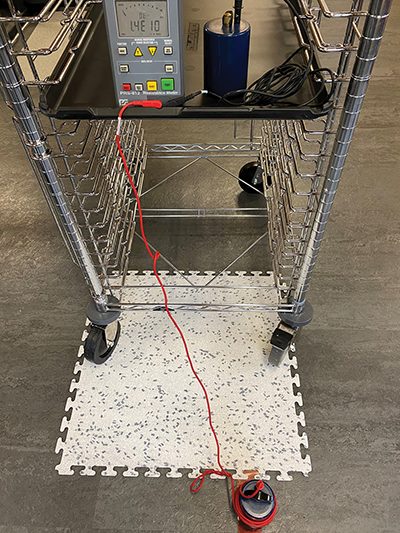
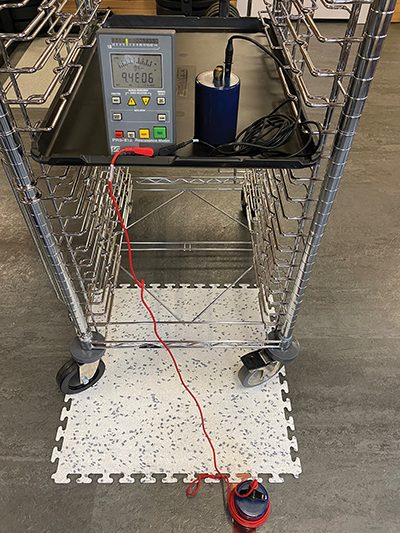
In Figure 2, the cart to ground measurement exceeds the limits (< 1.0 X 109) of ANSI/ESD S20.20. In Figure 3, a compliant measurement is the result of a minor change in the position of the same cart on the same floor tile. Just like the results in Table 1, these resistance measurements confirm a high correlation between negligible changes in caster placement and significant changes in resistance.
Like the cart shown in Figures 2 and 3, the carts used by the medical equipment manufacturer were built with four conductive casters. The resistance to ground between the cart and groundable point met ANSI/ESD requirements 84% of the time. An 84% pass rate means that, for 16% of the time, not a single conductive caster made adequate contact with the conductive chip floor.
Another way to look at this would be to view the data from the perspective of the probability of four consecutive events having the same outcome. In this case, the events would be simultaneous. For example, what is the probability of flipping heads four times in a row in a coin toss experiment? The equation would
be the odds of a single event occurring multiplied by itself four times, that is ½ x ½ x ½ x ½ = one in 16.
If we loosely apply this approach to our flooring problem (for simplification we are excluding particle density vs total area), we might say that after 100 tries we can randomly get all four casters to simultaneously not touch a conductive particle 16 times. So, what is the possibility of any single caster not touching a conductive particle? At a minimum, we are questioning the likelihood of four consecutive either/or events occurring. Our simple equation might look as follows. X times X times X times X = 16/100. So, if we solve for X, the fourth root of 16 equals two and the fourth root of 100 equals 3.1. Essentially the odds of any single caster not touching the conductive elements on the floor is 66%.
For starters, this presents a valid argument to install conductive casters on every cart post. But the real takeaway is to pull out that old statistics book and conduct a valid experiment before assuming any ESD floor will ground mobile workstations based on compliant ANSI/ESD 7.1 test results.
Effective Flooring is the Solution
This problem can be easily avoided when new floors are purchased. When evaluating an ESD floor, it’s imperative to evaluate the floor as part of the facility and the processes within the facility. Flooring should be tested for compatibility with all ESD mitigation components, including material handling processes. A fully functional floor can act as the anchor to all mobile grounding requirements.
A key attribute of many ESD floors is the ability to eliminate cumbersome and redundant tethering processes inside the EPA. ESD floors also eliminate the need for enclosing parts in covered tote boxes and shielding bags. But in order to eliminate the use of cumbersome packaging and tethering protocols, the floor must provide a compliant path to ground for mobile material handling fixtures on casters.
Some ESD floors cannot ground conductive casters effectively due to poor contact between casters or glides and a low density of conductive points or chips on the surface of the floor. In certain cases, this problem is exacerbated by a micro-thin factory application of low-maintenance polyurethane or ceramic coating on the floor’s surface. These UV-cured coatings reduce maintenance at a cost. Most testing shows that micro-thin coatings increase the floor’s electrical resistance and diminish the control of walking body voltage.
Chips vs. Conductive Veins
Some ESD vinyl tiles derive their conductivity from randomly located conductive chips similar to the tile shown in Figure 4. The black chips are the only conductive element on the tile surface. The rest of the surface is ordinary vinyl, that is, an insulative polymer that provides no connectivity to ground.

As illustrated in Figure 4, we can evaluate this liability by turning our NFPA probe on its edge and measuring a contact area between conductive chips and ground. The tile sample shown in the figure measured less than 1.0 x 106 when the full 31 cm2 probe surface was used in an ANSI/ESD S7.1 test. However, the polymer between the chips is nonconductive. When a caster contacts the non-conductive polymer in between chips instead of contacting a conductive chip, measurements change by over five orders of magnitude.
For a portable workstation or chair to meet ANSI/ESD S20.20, resistance to ground must be below 1.0 x 109.
Contact Area and Its Impact on Continuity
To understand the problem, we looked at the size of the conductive casters and tried to determine how much of their surface area actually touches the floor. First, we tucked four pieces of paper under the caster, sliding the paper from four different directions until it would not slide any further (see Figure 5).
When we lifted the paper, we expected to see a space where the four slips of paper did not meet. The space or void would show us approximately where the castor had been in contact with the floor. Before moving the caster, we taped the pieces of paper together so they would stay in place. Then we rolled the chair off the paper. Because we were able to tuck a fair amount of paper under the castor, we expected the contact area between the castor and floor tile to be small. We were surprised to see that it was barely larger than a sliver. In fact, the actual contact area was smaller than a dime (see Figure 5).
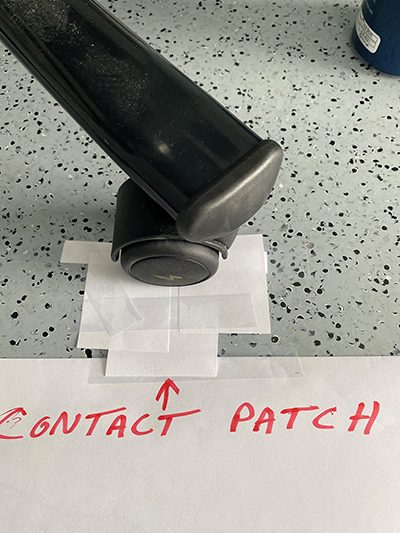

Think of the open space in the paper as a viewing window. We slid the window around the tile. When we don’t see a black chip inside the viewing window, we are looking at a section of tile that will not ground a caster. Even when it provides some degree of conductivity when most of the caster contact area rests on the void between chips, the resistance will likely measure above 1.0 x 109.
Caster Basics
A typical conductive caster measures approximately 10 cm in diameter but has a contact area of only one square cm. To put this in perspective, the NFPA probe used to measure the resistance from the surface of an ESD floor to ground has a contact area of 31 square centimeters. The distance between conductive particles used in a low-density chip technology (see Figure 9) ESD floor can measure from .5 cm up to 10 cm with an average of 2 to 5 cm. Therefore ANSI/ESD STM 7.1 resistance testing will not predict whether a particular floor will consistently provide electrical contact between casters and flooring.
The only way to make an accurate determination is by conducting a statistically valid sampling of resistance measurements using the carts, casters, and flooring that will be purchased by the facility. This should be done before any flooring is ordered. Once a floor has been installed, it is too late to address the problem. Most flooring manufacturers do not provide data or warranties involving caster contact resistance.

ESD Vinyl and Rubber with Conductive Vein Technology
If we place the same paper with the caster contact-sized viewing window on an ESD vinyl tile made with a tight matrix of conductive veins, we can move the window any place on the tile and still see veins. Due to the tight distance between veins in this conductive matrix, it’s impossible to find an area of the floor that is not conductive. This tight matrix of conductive veins increases contact opportunities between tiny caster surfaces and the conductive elements in the tile. Any place we see veins, the conductivity in the tile will ground chairs and carts.
ESD vinyl tiles made with conductive vein technology contain approximately 150 linear feet of conductive veins per square foot. To put this in perspective, the veins on thirty-six tiles provide one linear mile of conductive contact points. With this many conductive contact points, even contact from a single caster yields an ANSI S20.20-compliant measurement 100% of the time. Can this issue be resolved with floors using conductive chip technology?
Figure 8 provides a visual comparison between a low density (LD) dispersion conductive chip floor with a high density (HD) dispersion conductive chip floor. The distance between chips on an LD floor can range between .5 to 5 centimeters within the same tile or sheet. Chip distances rarely exceed .5 cm on an HD chip floor. Chip technology floors can be produced in sheets or rolls for seamless installations. Vein technology floors cannot be made in rolls due to limitations in the manufacturing process. Vein floors are only available as tiles.
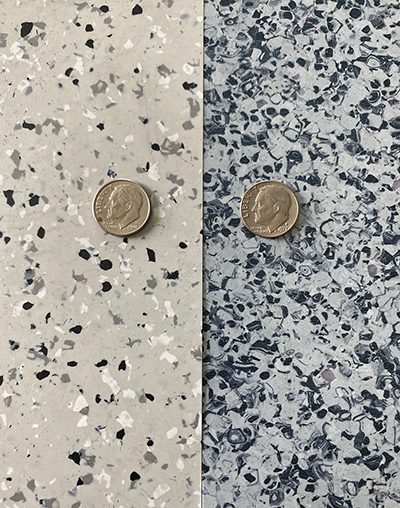
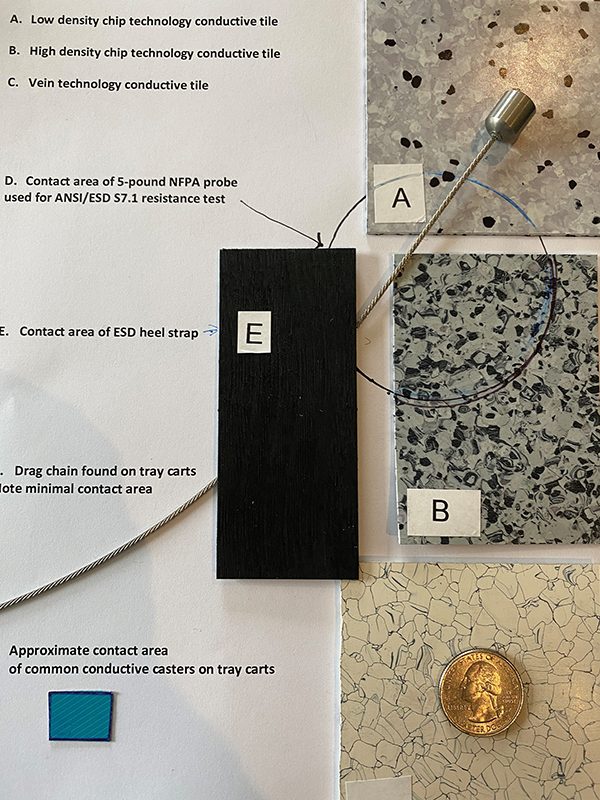
D—NFPA probe contact area = approx. 31 cm2
E—Typical heel strap: > 13 cm2
G—Caster contact area = 1 cm2
F—Ground chain contact area = negligible
Conclusions and Takeaways
ESD floors should be thoroughly evaluated for multiple functions, including compatibility with material handling equipment. There are two main technologies used for producing ESD tile and sheet flooring: conductive vein technology and conductive chip technology. The technology used to produce ESD flooring influences performance. Conductive vein floors outperform low and medium-density chip technology floors in instances where the floor must ground mobile workstations and carts. This is due to an inadequate number of conductive contact points in typical LD and medium-density conductive chip floors. New high-density chip technology solves this problem and offers the same level of performance as conductive vein technology floors.
To wrap up, here are a few key takeaways:
- Don’t assume compliant ANSI/ESD S7.1 test results validate a flooring material’s ability to ground mobile equipment on casters. STM 7.1 probes make 31 cm2 of contact. A caster only makes 1 cm2 of contact.
- Always perform a statistically valid sampling of ANSI/ESD STM 4.1 tests on shelving, carts, and mobile workstations using the ESD floor as ground surface.
- Always move casters and glides between tests. Slight variations in caster location contribute to extreme fluctuations in measurements. Perform tests in multiple areas. Tiles coated with urethane and ceramic exhibit variations from tile
to tile. - Test all potential cart/caster flooring combinations.
- Always use four conductive casters. Use conductive not dissipative casters.
- Never rely on drag chains for mobile workstation ground connections since the contact area is too small.
- Test before you buy. Install a test area of several tiles.
- As always, ESD floors must be tested for walking body voltage generation per ANSI/ESD 97.2.
